Crazy Colors Cuff
Fabulous Felt Desert Flower Barrette
Top: Self Esteem, JCPenney
Skirt: ELLE, Kohl's
Shoes: Qupid, Alloy
Bag: Delia's
Jacket: Bisou Bisou, JCPenney
Scarf: Mossimo, Target
Sunglasses: JCPenney
Emerald Empress Necklace
Tee: Merona, Target
Skirt (tucked-in dress): XOXO
Shoes: BCBG, Macy's
Bag: Nordstrom
Sunglasses: JCPenney
Fabulous Felt Phone Barrette
Top: Self Esteem, JCPenney
Skirt: Candie's, Kohl's
Shoes: Betsey Johnson, Macy's
Bag: Call it Spring, JCPenney
Bag: Call it Spring, JCPenney
Sunglasses: JCPenney
Some weeks ago, I mentioned that I was trying to buy less clothing. Since then, I've decided to take my endeavor to the next level by not washing any of my clothes, either -- at least not until I run out (pajamas, underwear, non-colorful stockings, sweat clothes, and socks excluded). Not, you understand, in a dirty bum kind of way (there's only so far I'll go for my art), but in a let's-see-how-long-I-can-keep-this-thing-going-before-I-end-up-in-a-muumuu kind of way. So far it's been a month, and my closet's still full. Not bursting, with dresses and blouses sticking out every which way like gas escaping from a buffet glutton, but comfortably full, like it just ate a delicious-but-sensible chicken dinner and isn't about to tempt fate by chasing it with a sundae. This experiment has forced me to think about just how much stuff I have as well as how many more different ways I can wear it. After all, if the yellow blouse that you usually wear with your green skirt is dirty, then you have no choice but to try a peach sweater or lavender tee. On a deeper level, this whole thing has made me redefine my relationship with stuff in general, with the collecting of it, the gazing at it, and the making the most of what's there.
Which is, as luck would have it, a right nice tie-in for my discussion of Hello, My Name is Doris. Starring Sally Field as the outlandishly dressed hoarder with a heart of gold title character, Doris is about a sixty-something woman's burning, obsessive infatuation with her office's new, much-younger art director (John, played by Max Greenfield). Or, at least that's what it's about on the surface. In reality it's about a woman coming to terms with her mother's death. Mild-mannered and imaginative, bow-bedecked, cat lady Doris is the thinking woman's Walter Middy. Part librarian, part little old lady-little girl hybrid, Doris is utterly charming and the perfect foil for her hard-nosed, no-nonsense pal Roz (Tyne Daly). She works as a data entry drone, slogging through her humdrum days by slipping into dream sequences starring her (sometimes shirtless) beloved, then at night retreating to her mother's clutter-choked, Staten Island homestead. Even her name is old-fashioned, not to mention the moniker of one of America's sweethearts (one Doris Day). According to her catty coworkers, Doris is a "weird, shy person." It's John who steps up and defends her as a "good kind of weird," setting the stage for the friendship that grows between them.
Spurred on by vulnerability, boredom, and a visit to a self-help guru (a charlatan [Peter Gallagher] who endorses turning the impossible into "I'm possible"), Doris enlists Roz's teenage granddaughter to help her stalk, er, pursue John. To that end, the film is filled with cringe-worthy, hide-your-head-under-the-pillow moments, many of which involve Facebook. Yet it isn't long before Doris takes her mission offline and out into the world, ingratiating herself with John's basic yet likable girlfriend (Beth Behrs) and braving the underground music scene. She's soon befriended by a circle of twenty- and thirty-something eccentrics who appreciate her eccentricities, too. What's more, her yellow jumpsuit, rainbow visor, and acres of day-glo jewelry land her an album cover for John's favorite band, an indie electronica group called Baby Goya. Yet despite all this new-found attention, getting closer to John remains her heart's desire. Over dinner, the two trade romantic war stories, with Doris revealing that she was once engaged. Her fiance was a journalist who got a job in Flagstaff, but she couldn't make the move, instead staying in New York to take care of her mother. I couldn't help but wonder how much happier she might have been in Arizona, decked out in bright colors against the southwestern landscape. Maybe she would've gotten a cool job or had a baby or mass-marketed her (albeit from a mix-except-for-the-blueberries) cornbread. It's these countless what-ifs that render her tale as miles more moving than John's. Up until this point their relationship has been lopsided, with John getting the sympathy.
Directed by Michael Showalter (Wet Hot American Summer, The Baxter, "Michael and Micheal Have Issues"), this funny, sweet, sometimes hard-to-watch story is a commentary on ageism and sexism as much as on having the courage to let your freak flag fly. Field is phenomenal as Doris, as convincing in her fears and foibles as she is in her epiphanies. Despite the 30-year age difference, I identified with Doris, and not just because we have the same pair of Hue pink polka dot stockings. As do we all at one time or another, I know what it's like to be different, to sometimes hold back and be afraid to do things.
Bookended by the imagery of opening and closing elevator doors, Hello, My Name is Doris is about one woman's much-delayed social debut. Doris begins as awkward and tentative, shrinking into the safety of her inner musings. But by the end, she's claimed command of herself, embracing the power of pushing the buttons to determine her own destination.
Some cacti in honor of Flagstaff.













No comments:
Post a Comment